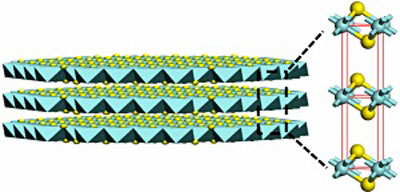|

08 August 2011
from
NatureAsia Website
|
The self-assembly of
two-dimensional inorganic ‘nanodiscs’ enhances the
capacity of lithium-ion batteries. |

Schematic
illustration of ZrS2 ‘nanodiscs’
that can stack
together and intercalate high densities of lithium ions
Two-dimensional materials such as
graphene have proved invaluable to battery researchers because their
sheet-like surfaces can absorb large amounts of charge.
Sheet-like transition metal
chalcogenides in particular have recently emerged as attractive
energy storage materials because the sheets formed by such compounds
can readily intercalate lithium ions.
Jinwoo Cheon and colleagues from
Yonsei University and Seoul National University in Korea have now
discovered a way to turn the chalcogenide
zirconium disulfide (ZrS2)
into two-dimensional nanoscale discs that can boost lithium
charge-discharge capacities by over 200% relative to bulk samples.1
Taking ZrS2 from a bulk, layered material down to nanoscale sheets
can lead to increased energy storage by opening up more surface area
and enhancing the diffusion of lithium ions. However, peeling apart
these strata is challenging because of the unstable, ‘dangling’
bonds that dot the edges of the two-dimensional surface.
Cheon and his co-workers took a colloid-based approach to resolve
this problem. By confining ZrS2 into two-dimensions through the use
of a surfactant called
oleylamine, the researchers were able to
isolate the compound as thin, circular sheets (see image).
Transmission electron microscopy showed that this simple procedure
gave single-crystalline ZrS2 discs with an average diameter of 20
nm.
Prolonging the reaction time enabled the
team to produce larger, 60 nm discs while retaining an ultrathin
width of 1.6 nm.
Although the researchers initially isolated the ZrS2 nanodiscs as a
colloidal dispersion, they soon found that immersing the materials
in a polar solvent provoked a unique self-assembly reaction.
Attractive forces between the protective surfactant molecules caused
the discs to stack up into well-defined cylinders, reminiscent of a
roll of coins.
Between each stacked disc sat a relatively empty gap of 1.5 nm -
perfect for accommodating a variety of molecules and ions, according
to Cheon.
Using the layered substances as anodes
in lithium-ion batteries revealed a pronounced nanoscale effect:
smaller discs held more ions and had quicker charge-discharge rates
than wider discs, a critical finding for the development of
next-generation batteries.
“The multiple layers of our
nanodiscs make them extremely useful for energy storage,
catalysis and separations,” says Cheon.
The team’s next goal is to extend the
versatility of their system by exploring solar energy conversion
applications.
Notes
-
1 - Jang, J.-T.1, Jeong, S.1,
Seo, J.-W.1, Kim, M.-C.1, Sim, E.1, Oh, Y.2, Nam, S.2, Park,
B.2 & Cheon, J.1 Ultrathin zirconium disulfide nanodiscs. J.
Am. Chem. Soc. 133, 7636-7639 (2011). |
article
Author affiliation
1. Department of Chemistry,
Yonsei University, Seoul 120-749, Korea
2. Department of Materials
Science and Engineering, and Research Institute of Advanced
Materials, Seoul National University, Seoul 151-744, Korea
|

